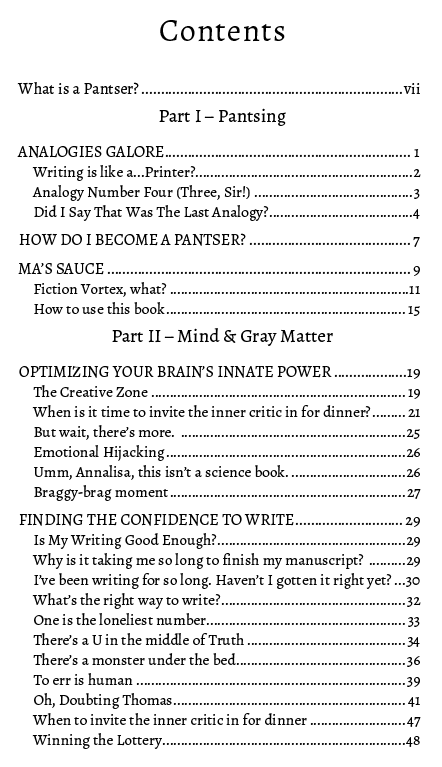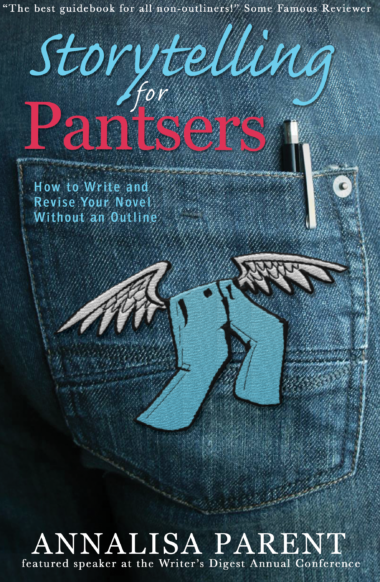
Storytelling for Pantsers
How to Write and Revise Your Novel Without an Outline
This book is intended to help those of us seat-flyers get at least some grounding in what we do, and to find and use a system in the chaos that is pantsing.
This book is for you if you:

Are still on chapter one
You should read this book if you have started a novel at least 68 times (the same novel) and only written the first chapter
Jump around
You should read this book if you write chapter 1. And then chapter 5. And then chapter 2. etc.
Write to Discover
You should read this book if you need to write to discover your story. (“I just watch my characters and write down what they do.”)
Get Lost in the Weeds
You should read this book if you get lost in the weeds of writing and revision because portions of your novel are in
different phases of the writing process.
Feel Writing is Complicated
You should read this book if you feel frustrated because “Dang it; writing’s hard enough. Why do I always have to
complicate it?”
Wear Pants
You should read this book if you think the cover of this book is cool, or wear pants. Because, hey, the cover is cool. So
are you, and so is this book. (Who says you can’t judge a book by it’s cover? Pshaw.)
What Others Have to Say...
Don't take my word for it, see what readers are saying...
Here’s what I love about Annalisa. Yes, she is hilarious; and yes, her book is brimming over with invaluable practical writerly wisdom. (An example among a thousand: when she talks about “the monsters under your bed.” Oh, you think there aren’t any?) But what I love is that her sheer love of great writing—in other words, her love of life—pours out of every paragraph. Read her book. It will infuse joy into your days and make you a better writer.

coauthor of the New York Times bestseller The Red Circle and the bestselling classic The Go-Giver
Storytelling for Pantsers is for all those writers who can’t do outlines, don’t plot their narratives, and just let their characters wander through forests and cities to see where they end up. And isn’t this just how we live our lives, wandering our forests and our cities? And that’s what is so great about Storytelling for Pantsers. It helps us write like we live, by wandering, by learning, by growing a little at a time.
So often we teach that creative writing is prescriptive. First, create a character. Second, create a plot. Third, create a setting. We turn our art into write-by-numbers until we’ve stolen the magic from it. Storytelling for Pantsers brings the creativity into creative writing. It teaches us to write organically, to follow our muse, but to follow it to the very end–a beautifully written book.
In Storytelling for Pantsers, Annalisa Parent writes a book designed for all those writers the other craft books don’t work for. Those other craft books (and I’ve written them) are designed for outliners, for folks who see their books from beginning to ending. But what about the rest of the writers? They should read this book. Its examples and ideas and illustrations and analogies will help them complete their beautiful novels.
Whether you are a pantser (like Annalisa) or an outliner (yup, me), Storytelling for Pantser is for you. It’ll help you start and finish your novel. It’ll help you think about how and why. It’ll teach you ideas and the science behind those ideas. It’ll allow you to explore while also moving forward toward that beautiful novel you have inside of you.
One of the things I love about Storytelling for Pantsers is that it allows us to be human as we write. It allows us to fail, to struggle, to second guess ourselves. But while we’re being human, Storytelling for Pantsers is guiding us toward successful writing, toward creating and completing the novels of our minds.

Author of Finding Abbey and Environmental and Nature Writing and editor of The Far Edges of the Fourth Genre
Want to Know More?
What Annalisa has to say about her book… and pantsers… and skinning cats… (really…)
Inside the Book
- Table of Contents 1
- Table of Contents 2
- Table of Contents 3
- Table of Contents 4
- Bonus Material

Storytelling for Pantsers
Author and Writing Coach Annalisa Parent approaches the topic with a mix of humor and depth that will spark your writing.

Are you a fly-by-the-seat-of-your-pants writer? Hungry for a book that shows you how to write and revise your novel without an outline?
Discover the secret sauce to help those of us seat-flyers get at least some grounding in what we do,
and to find and use a system in the chaos that is pantsing.

